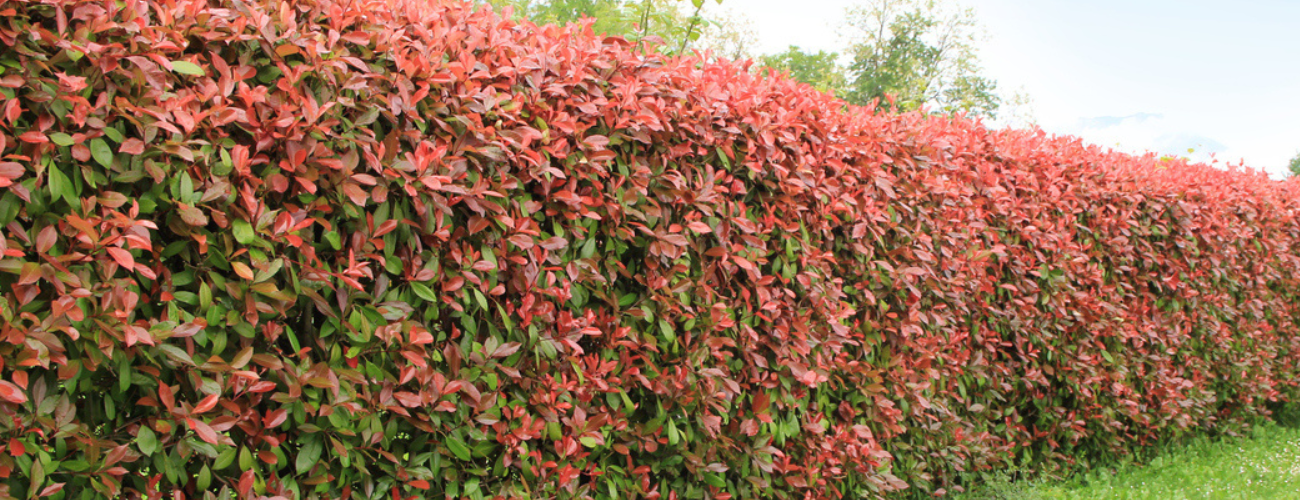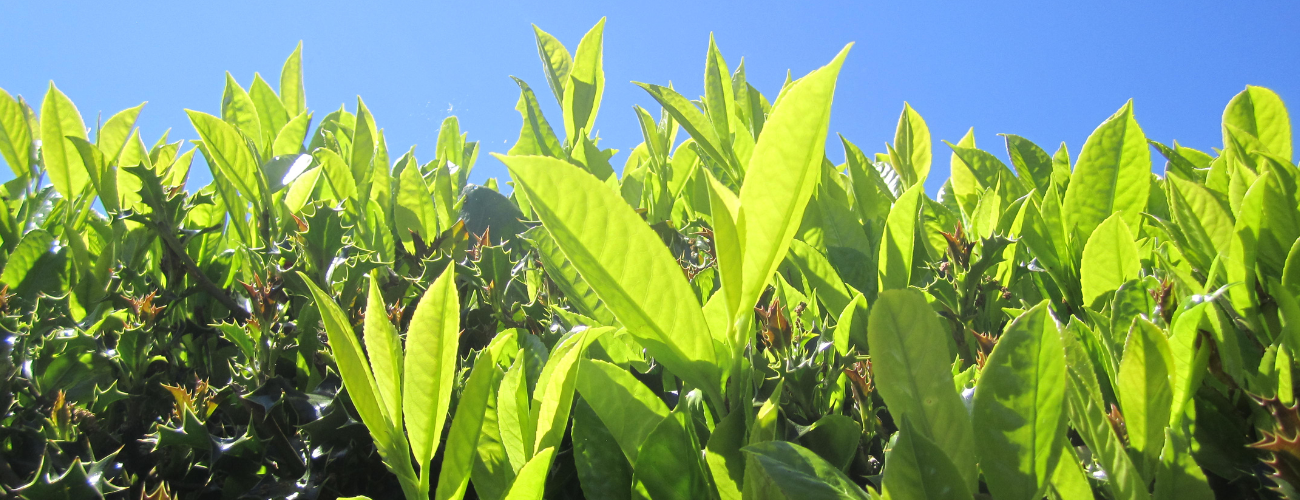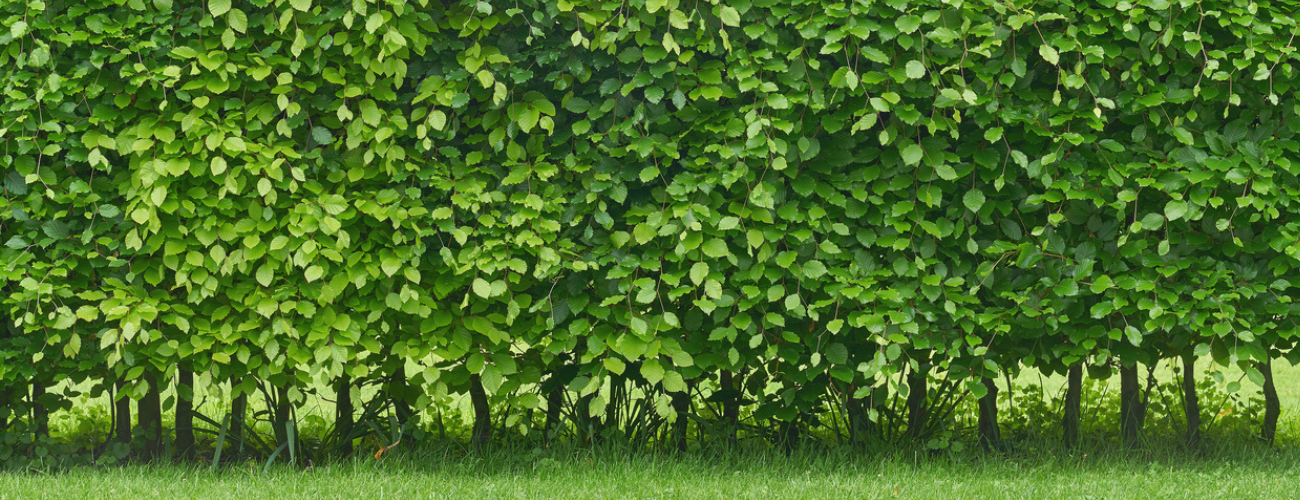What should I plant to make a hedge?
This question leads straight to new questions:
- What is the hedge for? Is it to mark a boundary, for screening or privacy, for protection against intrusion from people or animals, for wildlife, to divide up a space, as a backdrop for garden colour or for a windbreak? In exposed locations hedges as windbreaks are better than fencing because they filter the wind rather than being a solid barrier which can blow down. Windbreaks reduce wind on the leeward side to a distance of ten times its height. So a 2 metre tall hedge will soften the wind for 20 metres.
- How will you maintain it? Many hedges will require regular maintenance such as trimming and pruning, often several times a year. Often this will require time and specialized equipment or paying someone to do it for you and the disposal of all the clippings.
- How tall or short do you want your hedge to be?
- What are your soil conditions? Are you on thin chalky soil or perhaps clay which gets very soggy in winter? You need to choose a plant variety which will be happy in your soil.

Evergreen hedges offer more privacy but less light, particularly in the winter when the sun is lower. Popular evergreen choices for taller boundary hedging include Photinia red robin, Prunus laurocerasus ‘Rotundifolia’ (cherry laurel), Bamboo, privet, yew (slow growing) and Leylandii (fast growing). The fastest growing hedge is Leylandii, however be aware that when it reaches the height you want it won’t stop growing and will require regular cutting to keep it to size. Yew may only need cutting once each year but Leylandii will need cutting multiple times.
Popular evergreen choices for shorter hedges to divide spaces or make a boundary around areas, for example a front garden, include Buxus (Box), Ilex crenata and yew. Buxus in recent years has become problematic due to the Box Moth Caterpillars which can reduce a hedge to twigs in a short space of time and the Box Blight disease which can cause Buxus to die back or kill plants. Both are very prevalent across the south of the UK and they have caused many people to remove their Box hedging and replace it with alternatives such as Ilex crenata, pittosporum, euonymus or yew. Lavender also makes a really pretty low hedge.
Deciduous hedging filters the stronger winter winds better than evergreen hedges and are more forgiving regarding pruning and trimming. Popular deciduous hedging includes hornbeam and beech which holds onto its brown leaves until spring or you could consider a mixed (native) hedge, which is an excellent choice for encouraging wildlife and is often prickly in parts which is good for security around a property. You can also create an edible mixed hedge with blackthorn (sloe), hazel, crab apples etc., or a single crop hedge such as trained apples or black/red currant bushes. A mixed hedgerow will likely need to be wider than a clipped hedge.
When to plant hedging
The best time to plant any evergreen shrubs or trees is in the early autumn; the soil will still be warm enough to be welcoming and the plant will begin to put down good roots in the damp soil ready to grow away enthusiastically in spring. However they can be planted at any time between autumn and late winter if the soil is workable. Deciduous hedging can be planted at any time through the dormant season as long as the soil is not frozen or waterlogged.
From November onwards you are likely to find a selection of deciduous hedging and trees available as bare-rooted plants. Deciduous specimens stop almost all cellular activity during the winter and need very little except dampness around their roots. Only a limited number of evergreens are available as bare-root because evergreens generally do not go dormant in the same way and will still be growing. Although this is the cheapest way to plant a hedge you will be waiting a quite a few years before you have a formed hedge. It is worth erecting a temporary screen of fine netting or windbreak material to create privacy while the hedge grows.

How to plant a hedge
Preparing the ground at least a few days before planting will give your hedge the best start and could make a huge difference to how well your hedge grows and how healthy it becomes. Prepare the ground by digging over a strip 30cm wide along the hedge line for smaller plants and 60cm wide for larger plants or double rows, removing all the weeds, debris and other roots as you go. To ensure a straight line set up a string line or two lines if planting a double row. Bone meal is an organic fertilizer that promotes root growth and will help your hedge establish. Mix bone meal into the soil as you go; bone meal should not come into direct contact with the roots as it can scorch them which is why its good to prepare ahead of time. Break up the bottom of the trench to ensure good drainage.
For bare root hedging space plants 35cm apart in a single row (3 plants per metre) and staggered in a w shape at 45cm apart in a double row. (5-7 plants per metre). Make sure the tide marks on the stems are at soil level when planted. Spacings of evergreens depends on the size of the plants and root balls you buy. The smaller the plants the closer together you can plant and the more quickly they will merge to create a hedge.
Sprinkle mycorrhizal fungi across the bottom of each hole to make contact with the roots when planting. Water in thoroughly and mulch the row generously with bark chippings to retain moisture and suppress weeds. When backfilling the holes or trench around your plants mix in some compost or well-rotted manure to the soil.

How to look after a new hedge
During the first two years after planting, keep on top of watering and weeding around your hedge particularly during dry spells. Water heavily once or twice each week rather than small amounts daily. Check your plants regularly to ensure strong winds have not loosened them and firm back in if needed. Every Spring, add a slow release fertilizer to the base of the hedge and fork in without disturbing the roots, then top up the mulch. If rabbits are a local problem then add spiral guards to your bare root hedging.
Once your hedge has reached a size that it requires trimming please remember that it is against the law to disturb birds that are building or occupying a nest. If you need to use machinery to trim your hedge you must do so outside of the nesting season. As a general rule deciduous hedges should be cut in winter whilst they are dormant and evergreen hedges between early summer and autumn, but look up individual varieties of plants for more accurate information. Young hedges should have an initial prune within their first or second year to help them bush out.
A hedge can be a low cost way to create boundaries for your garden that will last a life time. A good well tended hedge can provide shelter and food for both yourself and local wildlife and natural beauty for your surroundings, but you are responsible for looking after any hedge on your property to ensure it does not become a nuisance to anyone else. Under the Antisocial Behaviour Act 2003 a ‘High Hedge’ is defined as an evergreen hedge of more than 2 metres and a hedge as being a line of three or more evergreens. High Hedges cause more trouble between neighbours than almost any other issue; your hedge can be more than 2 metres high provided it doesn’t block too much light from your neighbours property. There is no restriction on the height of bamboo but you should choose a non spreading one. Talk to your neighbours first about maintenance if the hedge borders their property: how will their side of the hedge be maintained? The following is a useful government article about hedges: https://www.gov.uk/government/publications/over-the-garden-hedge/over-the-garden-hedge
By our resident horticultural expert











